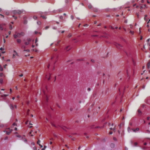Next Steps
Although novel, even disease-modifying therapies for OA are in development now, NSAIDs are still widely used by patients to manage joint pain.7 The 2019 ACR/Arthritis Foundation Guideline for the Management of Osteoarthritis of the Hand, Hip and Knee includes oral NSAIDs as one of its recommendations.8 Thus, it is important for rheumatologists and other healthcare providers to watch for signs of CVD and discuss the risks of NSAID use with their patients, says Prof. Anis.
“We now know that the use of NSAIDs plays a substantial role in developing cardiovascular diseases among people with OA. The findings of this study highlight the importance of monitoring for cardiovascular adverse effects among OA patients,” he says. “Patients should receive counseling so they know the risks and use NSAIDs cautiously.”
Susan Bernstein is a freelance journalist.
References
- Atiquazzaman M, Karim M, Kopec J, et al. Role of nonsteroidal anti-inflammatory drugs (NSAIDs) in the association between osteoarthritis and cardiovascular diseases: A longitudinal study. Arthritis Rheumatol. 2019 Nov;71(11):1835–1843.
- Rahman MM, Kopec JA, Anis AH, et al. Risk of cardiovascular disease in patients with osteoarthritis: A prospective longitudinal study. Arthritis Care Res (Hoboken). 2013 Dec;65(12):1951–1958.
- Roumie CL, Mitchel EF Jr., Kaltenbach L, et al. Nonaspirin NSAIDs, cyclooxygenase 2 inhibitors and the risk for stroke. Stroke. 2008 Jul;39(7):2037–2045.
- Wang H, Bai J, He B, et al. Osteoarthritis and the risk of cardiovascular disease: A meta-analysis of observational studies. Sci Rep. 2016 Dec 22;6:39672.
- Rahman MM, Kopec JA, Cebire J, et al. The relationship between osteoarthritis and cardiovascular disease in a population health survey: A cross-sectional study. BMJ Open. 2013 May 14;3(5):e002624.
- Lange T, Vansteelandt S, Bekaert M. A simple unified approach for estimating natural direct and indirect effects. Am J Epidemiol. 2012 Aug 1;176(3):190–195.
- Ghouri A, Conaghan PG. Update on novel pharmacological therapies for osteoarthritis. Ther Adv Musculoskelet Dis. 2019;11:1759720X19864492.
- Kolasinski SL, Neogi T, Hochberg MC, et al. 2019 American College of Rheumatology/Arthritis Foundation guideline for the management of osteoarthritis of the hand, hip and knee. Arthritis Rheumatol. 2020 Feb;72(2):220–233.


